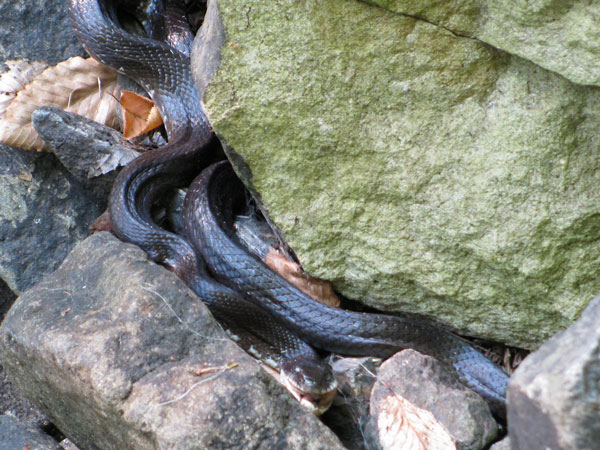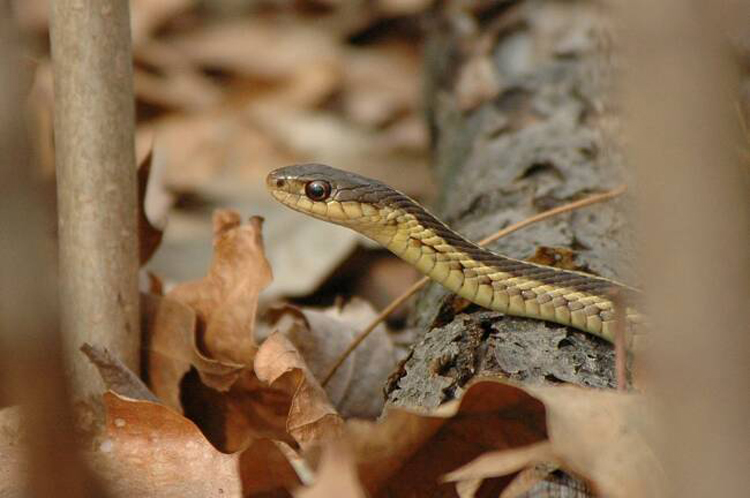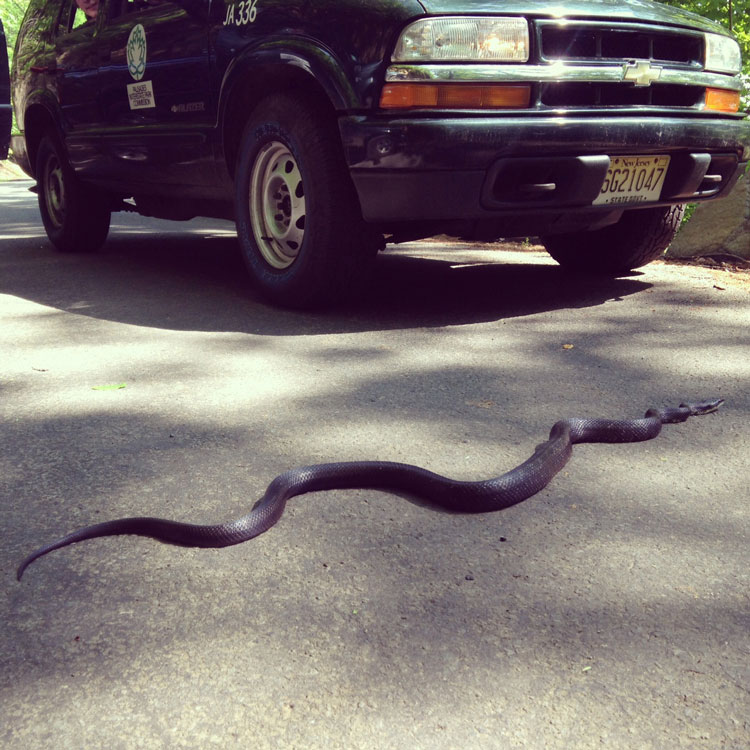Snakes in a Park
A “Cliff Notes” Story
July 2007
Threatened or cornered, of course, any animal will try to defend itself. But left alone, none of the several species of snakes that live in this park is harmful to humans. Sadly, however, we sometimes encounter snakes that were obviously killed by humans.
The only venomous snake found in the park these days (rattlers were known to inhabit the Palisades in the past) is the eastern copperhead. This snake is rarely seen, and if encountered, one need only give it a wide berth. (And please keep your dog on a leash when on our trails — he or she is much more likely to get bitten by a copperhead than you are.)

Perhaps the most commonly seen snake in the park is the black rat snake (also known simply as the black snake). Adult black rat snakes are generally solid black or dark brown on top from head to tail, with a blotched white underbelly. Young black rat snakes are somewhat more brightly patterned, with black or dark brown blotches on a white or light gray background on their back, but this patterning (which often gets them mistaken for copperheads) fades, and the young reach adult coloration in two to three years. Black rat snakes are, in fact, one of the largest snakes in North America: when hatched, they are about 11 to 13 inches in length, but can reach up to 8 feet long in adulthood, although snakes 5 to 6 feet long are more common, with a body diameter of about 1½ to 2 inches. Despite their size, rat snakes are non-aggressive, non-venomous constrictors. When approached, they usually neither flee nor attack, but instead may freeze and coil or crinkle themselves into a series of kinks. They will also sometimes vibrate their tails in dead leaves to simulate a rattle sound to scare off predators. Of course, like all wild animals, rat snakes will bite if provoked or captured. If picked up, they may also release a foul-smelling musk and spread it on their predator (or captor) with their tail. (If you encounter a rat snake on a trail or other area, you can safely step over or around them.)

Black rat snakes are found throughout North America, and prefer heavily wooded areas. They are strong swimmers, but they are especially known for their climbing ability, and black rat snakes spend much of their time in trees, often scaling large trees without the aid of branches. They are rarely active at night and can often be seen basking out in the open during the spring, summer, and fall months. Black rat snakes have indiscriminate diets: while they usually eat small rodents such as mice, chipmunks, and rats, they also eat birds, bird eggs, and even small frogs.
The northern ringneck snake and the eastern milk snake are two species of snakes known to live in the park but are rarely seen. The ringneck is shiny and uniformly slate gray, dark blue, or black with a slim yellow to orange band around its neck just below the head and a similarly colored underside. It averages about 12 to 15 inches in length, though it can grow as long as 27 inches. Also a non-venomous constrictor, it prefers shady or heavily wooded damp areas, usually near freshwater rivers and ponds, areas in which its prey — insect larvae, earthworms, small frogs, and especially salamanders — live. It is a small and secretive snake, nocturnal like its prey, and during the day hides under rocks and forest litter. When threatened, ringnecks coil their tails to show their brightly colored undersides, and they may release a pungent fluid, but they will rarely bite. (Given its habitat needs, the ringneck snake is usually seen in wet areas along the Palisades such as Greenbrook Sanctuary.)
The eastern milk snake is one of several subspecies of milk snake found throughout North America and a type of kingsnake. It is a slender snake, usually 24–36 inches long and gray to tan with three rows of large, dark, reddish-brown blotches, bordered in black, along the length of its body. There is wide variation in coloring across the species, however, and some milk snakes appear as solid dark brown or gray, with blotches of the same color. The more colorfully marked snakes look similar to the copperhead, although the two are distinguishable: the copperhead is more, well, coppery, and has dark bands of color crossing its back, rather than the individual blotches of the milk snake; the copperhead also has a triangular head. Milk snakes, unlike copperheads, are non-venomous constrictors. They are fairly opportunistic eaters, mostly hunting rodents but also known to eat eggs, birds, and reptiles, including other snakes (like other kingsnakes, they are relatively immune to the venom of poisonous snakes). They are diurnal in the spring and fall and nocturnal in the summer. They, too, are secretive snakes, rarely found or seen out in the open, and usually hide under rocks, logs, and debris. They avoid humans if approached and will bite if captured. Like the black rat snake, milk snakes also release musk or vibrate their tails in self-defense.

The garter snake is a common sight not only in the park, but throughout North America. Most garter snakes (sometimes referred to as “garden snakes”) are less than 24 inches long, dark-colored with three light stripes — usually yellow — running the length of their bodies. Between the stripes are often rows of blotches. (This patterning was considered reminiscent of a garter, hence the snake’s name.) One of the key identifying features of the garter snake is its bright red tongue. Active during daylight hours, garter snakes can be seen basking in the sun during warm weather months. Neither poisonous or a constrictor, the garter snake will consume almost anything it can overpower, including mice, salamanders, frogs, and earthworms. Like the other snakes in the park, the garter snake avoids humans, and if disturbed, will usually hide its head and flail its tail, and may strike or emit a malodorous scent.
A cautious respect for wild animals is a good thing, but it is a shame when this becomes an irrational fear. For humans who use this park, it is a place for recreation and enjoyment; but for the snakes described in this article, it is home.

– Emory Davis –

